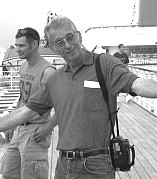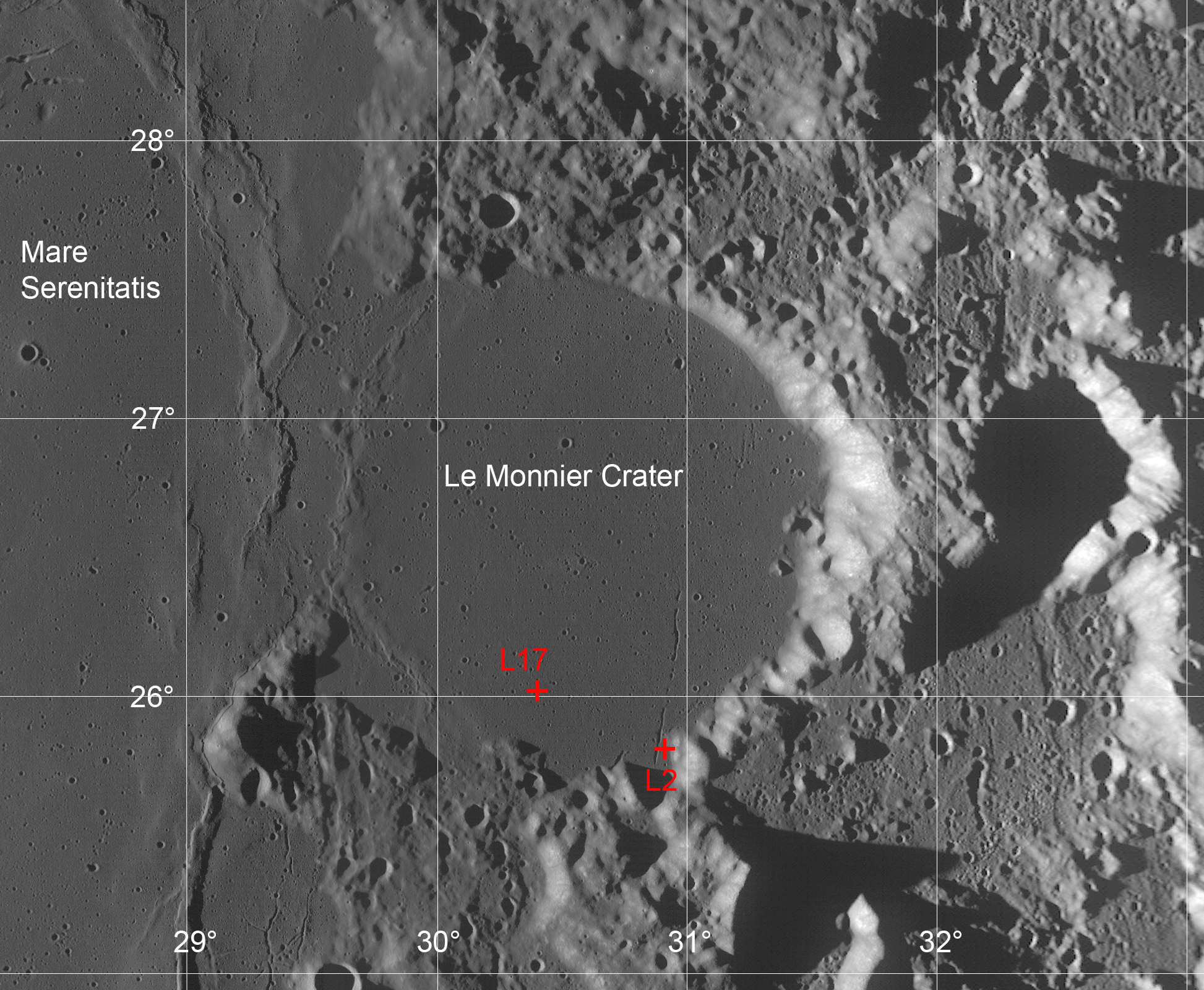|
|
 Fran Ridge |
|
|
 Fran Ridge |
MONOLITH NEAR LUNoKHOD 2
Strange
object found on moon
 Le Monnier Crater 20190126 By Rick Sterling & Fran Ridge Section 25 on the lunar near side is called Romer and is the home of Le Monnier Crater. It is a mountainous area adjoining Mare Serenitatis and Mare Tranquilitatis. Romer is surrounded by a dense field of craters with disintegrated walls. The region of Romer, Chacornac and Littrow has a system of conspicuous rilles. The Apollo 17 expedition landed in a valley between mountains to the north of Littrow. Lunokhod 2 was active in le Monnier. The location of the "lost Lunokhod" has been discovered. STRANGE OBJECT FOUND ON MOON (APRO Bulletin Jan-Feb 1973) http://www.openminds.tv/pdf/apro-bulletins-searchable/08_APRO_Jan_Feb_1973.pdf The February 19, 1973 issue of Soviet Aerospace carries an interesting article about a "monolith" found in the Sea of Serenity while Lunokhod 2, a remote controlled, unmanned lunar expeditionary module, was operating in the foothills of the Taurus Mountains. Lunarkhod is guided by human controllers at Zvezdnoy Gorodok (Star City) ouThe article stated that the "stone plate which has so puzzled scientists" has a smooth surface which is unlike the large stones in the area and that it withstood "the buggy's pressure of a hundred atmospheres" ( 1,470 lb. per square inch) which left only slight traces on the thin layer of dust which covered the plate. Also, the article said, scientists have determined that the plate "seems much younger" than other stone material in the area. Because of the monolith's uniqueness, scientists decided to continue to investigate it to determine its chemical composition and magnetic properties, as well as transmit TV photos. The object was found on February 13 and plans were made to continue the investigation through the 16th. The bedrock in the immediate area was described as being different from the material observed and tested earlier and because the monolith is also so different from the surrounding bedrock the scientists were wondering if such a combination is accidental. If further information on this discovery is forthcoming it will be published in a future issue of the Bulletin.(Transcript by Theo Paijmans) MOON MOUNTAINS PROBED BY ROBOT http://lunascan.com/submittals/sterling/images/nevada-state-journal-Feb-14-1973-p-13.pdf http://lunascan.com/submittals/sterling/images/nevada-state-journal-Feb-14-1973-p-1.pdf MOSCOW (UPI) — The Lunokhod 2 moon robot parked just over a mile from the Taurus Mountains Wednesday and probed an unusual slab of smooth rock blasted into view by a large meteor, the Soviet Tass news agency said. "Lunokhod 2 has begun exploring an unusual piece of lunar material thrown out from the moon's interior during the birth of a big crater," Tass said "This one-meter (39 1 inches) long plate, resembling a modern house panel, has proved to be a strong monolith." The eight - wheeled robot, which arrived on the moon Jan. 16, was nearly three miles from its landing site on the Sea ot Serenity. The Soviet moon buggy left only slight traces on the thin layer of dust on the spotlighted rock, Tass said. "The plate has a smooth surface, whereas giant stones lying nearby are pockmarked with holes of craters left by tiny meteorites," it added. The robot is further exploring the plate to determine its chemical composition and magnetic properties Tass said "it seems much younger" than other stones UPI & TASS REPORTS OF LUNOKHOD 2 MONOLITH https://archive.org/stream/ Secrets of Our Spaceship Moon-Page 250- The hopes of man sometimes are translated into fantasy writings. And as some philosopher has said “the wish is the father of the thought”. Scientists had longed to find evi¬ dence to prove that man is not alone in the universe. It was not surprising that the great science fiction writer Arthur Clarke came up with a very popular book and film 2001: A Space Odyssey which projected the discovery of such an alien artifact—a huge monolith buried on the Moon that emitted strong radio waves when discovered. Now amazingly it appears that the Soviet Union’s space probe has discovered a startlingly similar artifact. For a UPI news report based on a Soviet government announce¬ ment claims that on February 14, 1973 a Russian remote controlled space robot (Lunokhod 2) while probing the Taurus Mountain region (the same region ironically where we sent our last Apollo probe Apollo 17) discovered an unusual monolith,' a smooth stone slab about a meter long, which remarkably resembled the smoothly carved stone monolith much like the one in 2001: A Space Odyssey. The Soviet government report (announced by Tass) indi¬ cated it was like a sculptured piece of stone, “a plate . . . (with) a smooth surface”. The full UPI news report stated: • The Lunokhod 2 moon robot parked just over a mile from the Taurus Mountains Wednesday (Febru¬ ary 14) and probed an unusual slab of smooth rock blasted into view by a large meteor, the Tass News Agency said. • This one-meter long plate has proved to be a strong monolith. The eight-wheeled robot, which arrived on the moon January 16, was nearly three miles from its landing site on the Sea of Serenity. • The plate has a smooth surface, whereas giant stones lying nearby are pockmarked with holes of craters left by tiny meteorites, Tass said. If such a discovery has actually been made, it is mind- boggling. From NASA SP-4018-Page 43-" The U.S.S.R. ground control commanded the lunar explorer Lunokhod 2 to unfold its solar battery panel and begin its second lunar day of exploration. The moon car explored its parking area-a small deep crater with outcroppings of bedrock at its edge, formed 3 million yrs ago by a large meteorite that hit the surface of congealed lava. Lunokhod 2 made measurements of the magnetic field inside the crater by approaching it four times from different directions and making 120 precision maneuvers. The vehicle moved southeasterly to the Taurus Mountains. En route it measured physicomechanical properties of the soil and tension of the local magnetic fields, took panoramic photos of surrounding terrain, and tested riding characteristics of the lunar vehicle in various modes of operation. A monolith one meter (three feet) long of unusual lunar material was discovered Feb. 13. The plate had a strong, smooth surface unlike surrounding pockmarked stones and appeared to be much younger. During exploration of the giant crater Lunokhod 2 skidded and swerved over 2.3 km (1.4 mi) of difficult terrain with slopes up to 25" and sank in dust to the hub of its wheels as it ascended the rim of the crater. At the top of the rim, TV cameras showed a complex surface with ejecta piled on the rims of lunar holes formed when three meteorites hit the area within millions of years. Lunokhod 2 descended the slope of a 100-m (330-ft) crater, leaving deep ruts in loose rock. The difficult ascent was interrupted for 20 hrs to replenish electrical energy Feb. 19. Lunokhod 2 had covered 9.6 km (6.0 mi) since landing on the moon Jan. 16. (Tass, FBIS-SOV, 2/14/73, L1; 2/15/73, L2-L3; 2/21/73, L2-L3)" Dr. Carlotto & Francis, Notice the reference in this NASA document to TASS Feb. 14,1973. This is the TASS story which discussed the Lunokhod 2 Monolith. https://ntrs.nasa.gov/archive/ http://www.oasi.org.uk/Misc/Lunokhod.php On 14 February, in an area almost 5 km distant from the landing site and at an altitude some 300 m higher, in the foothills of the Taurus Mountains, Lunokhod 2 discovered an unusual piece of moonrock, which had been ejected from the interior of the Moon by an impact which resulted in the formation of a large crater. The rock was approximately one metre in length and proved to be an extremely strong monolith: a pressure of 100 atmospheres applied to it left only slight marks. It had a smooth surface whereas rocks lying nearby were pockmarked with tiny craterlets, indicating that it was much younger than most of the rocks in the vicinity (the majority of which are tens and even hundreds of millions of years old)." |